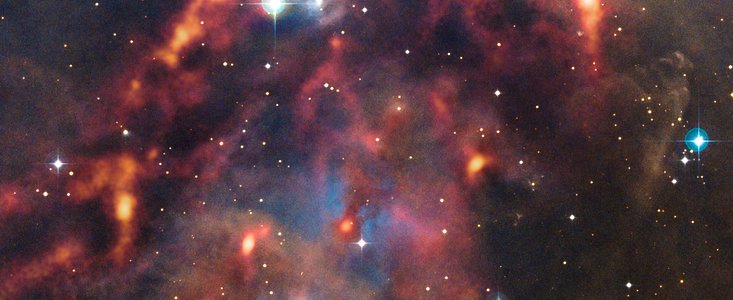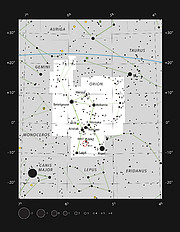Press Release
Setting the Dark on Fire
23 January 2013
A new image from the Atacama Pathfinder Experiment (APEX) telescope in Chile shows a beautiful view of clouds of cosmic dust in the region of Orion. While these dense interstellar clouds seem dark and obscured in visible-light observations, APEX’s LABOCA camera can detect the heat glow of the dust and reveal the hiding places where new stars are being formed. But one of these dark clouds is not what it seems.
In space, dense clouds of cosmic gas and dust are the birthplaces of new stars. In visible light, this dust is dark and obscuring, hiding the stars behind it. So much so that, when astronomer William Herschel observed one such cloud in the constellation of Scorpius in 1774, he thought it was a region empty of stars and is said to have exclaimed, "Truly there is a hole in the sky here!" [1]
In order to better understand star formation, astronomers need telescopes that can observe at longer wavelengths, such as the submillimetre range, in which the dark dust grains shine rather than absorb light. APEX, on the Chajnantor Plateau in the Chilean Andes, is the largest single-dish submillimetre-wavelength telescope operating in the southern hemisphere, and is ideal for astronomers studying the birth of stars in this way.
Located in the constellation of Orion (The Hunter), 1500 light-years away from Earth, the Orion Molecular Cloud Complex is the closest region of massive star formation to Earth, and contains a treasury of bright nebulae, dark clouds and young stars. The new image shows just part of this vast complex in visible light, with the APEX observations overlaid in brilliant orange tones that seem to set the dark clouds on fire. Often, the glowing knots from APEX correspond to darker patches in visible light — the tell-tale sign of a dense cloud of dust that absorbs visible light, but glows at submillimetre wavelengths, and possibly a site of star formation.
The bright patch below of the centre of the image is the nebula NGC 1999. This region — when seen in visible light — is what astronomers call a reflection nebula, where the pale blue glow of background starlight is reflected from clouds of dust. The nebula is mainly illuminated by the energetic radiation from the young star V380 Orionis [2] lurking at its heart. In the centre of the nebula is a dark patch, which can be seen even more clearly in a well-known image from the NASA/ESA Hubble Space Telescope.
Normally, a dark patch such as this would indicate a dense cloud of cosmic dust, obscuring the stars and nebula behind it. However, in this image we can see that the patch remains strikingly dark, even when the APEX observations are included. Thanks to these APEX observations, combined with infrared observations from other telescopes, astronomers believe that the patch is in fact a hole or cavity in the nebula, excavated by material flowing out of the star V380 Orionis. For once, it truly is a hole in the sky!
The region in this image is located about two degrees south of the large and well-known Orion Nebula (Messier 42), which can be seen at the top edge of the wider view in visible light from the Digitized Sky Survey.
The APEX observations used in this image were led by Thomas Stanke (ESO), Tom Megeath (University of Toledo, USA), and Amy Stutz (Max Planck Institute for Astronomy, Heidelberg, Germany). APEX is a collaboration between the Max Planck Institute for Radio Astronomy (MPIfR), the Onsala Space Observatory (OSO) and ESO. Operation of APEX at Chajnantor is entrusted to ESO.
Notes
[1] In German, "Hier ist wahrhaftig ein Loch im Himmel!"
[2] V380 Orionis has a high surface temperature of about 10 000 Kelvin (about the same in degrees Celsius), nearly twice that of our own Sun. Its mass is estimated to be 3.5 times that of the Sun.
More information
The year 2012 marks the 50th anniversary of the founding of the European Southern Observatory (ESO). ESO is the foremost intergovernmental astronomy organisation in Europe and the world’s most productive ground-based astronomical observatory by far. It is supported by 15 countries: Austria, Belgium, Brazil, Czechia, Denmark, France, Finland, Germany, Italy, the Netherlands, Portugal, Spain, Sweden, Switzerland and the United Kingdom. ESO carries out an ambitious programme focused on the design, construction and operation of powerful ground-based observing facilities enabling astronomers to make important scientific discoveries. ESO also plays a leading role in promoting and organising cooperation in astronomical research. ESO operates three unique world-class observing sites in Chile: La Silla, Paranal and Chajnantor. At Paranal, ESO operates the Very Large Telescope, the world’s most advanced visible-light astronomical observatory and two survey telescopes. VISTA works in the infrared and is the world’s largest survey telescope and the VLT Survey Telescope is the largest telescope designed to exclusively survey the skies in visible light. ESO is the European partner of a revolutionary astronomical telescope ALMA, the largest astronomical project in existence. ESO is currently planning the 39-metre European Extremely Large optical/near-infrared Telescope, the E-ELT, which will become “the world’s biggest eye on the sky”.
Links
- The research into the dark patch in NGC 1999 discussed above is described in a paper by T. Stanke et al., A&A 518, L94 (2010), also available as a preprint.
Contacts
Thomas Stanke
ESO
Garching, Germany
Tel: +49 89 3200 6116
Email: tstanke@eso.org
Douglas Pierce-Price
ESO ALMA/APEX Public Information Officer
Garching, Germany
Tel: +49 89 3200 6759
Email: dpiercep@eso.org
About the Release
| Release No.: | eso1304 |
| Name: | NGC 1999 |
| Type: | Milky Way : Nebula : Type : Star Formation |
| Facility: | Atacama Pathfinder Experiment |
| Instruments: | LABOCA |
| Science data: | 2010A&A...518L..94S |
Our use of Cookies
We use cookies that are essential for accessing our websites and using our services. We also use cookies to analyse, measure and improve our websites’ performance, to enable content sharing via social media and to display media content hosted on third-party platforms.
ESO Cookies Policy
The European Organisation for Astronomical Research in the Southern Hemisphere (ESO) is the pre-eminent intergovernmental science and technology organisation in astronomy. It carries out an ambitious programme focused on the design, construction and operation of powerful ground-based observing facilities for astronomy.
This Cookies Policy is intended to provide clarity by outlining the cookies used on the ESO public websites, their functions, the options you have for controlling them, and the ways you can contact us for additional details.
What are cookies?
Cookies are small pieces of data stored on your device by websites you visit. They serve various purposes, such as remembering login credentials and preferences and enhance your browsing experience.
Categories of cookies we use
Essential cookies (always active): These cookies are strictly necessary for the proper functioning of our website. Without these cookies, the website cannot operate correctly, and certain services, such as logging in or accessing secure areas, may not be available; because they are essential for the website’s operation, they cannot be disabled.
Functional Cookies: These cookies enhance your browsing experience by enabling additional features and personalization, such as remembering your preferences and settings. While not strictly necessary for the website to function, they improve usability and convenience; these cookies are only placed if you provide your consent.
Analytics cookies: These cookies collect information about how visitors interact with our website, such as which pages are visited most often and how users navigate the site. This data helps us improve website performance, optimize content, and enhance the user experience; these cookies are only placed if you provide your consent. We use the following analytics cookies.
Matomo Cookies:
This website uses Matomo (formerly Piwik), an open source software which enables the statistical analysis of website visits. Matomo uses cookies (text files) which are saved on your computer and which allow us to analyze how you use our website. The website user information generated by the cookies will only be saved on the servers of our IT Department. We use this information to analyze www.eso.org visits and to prepare reports on website activities. These data will not be disclosed to third parties.
On behalf of ESO, Matomo will use this information for the purpose of evaluating your use of the website, compiling reports on website activity and providing other services relating to website activity and internet usage.
Matomo cookies settings:
Additional Third-party cookies on ESO websites: some of our pages display content from external providers, e.g. YouTube.
Such third-party services are outside of ESO control and may, at any time, change their terms of service, use of cookies, etc.
YouTube: Some videos on the ESO website are embedded from ESO’s official YouTube channel. We have enabled YouTube’s privacy-enhanced mode, meaning that no cookies are set unless the user actively clicks on the video to play it. Additionally, in this mode, YouTube does not store any personally identifiable cookie data for embedded video playbacks. For more details, please refer to YouTube’s embedding videos information page.
Cookies can also be classified based on the following elements.
Regarding the domain, there are:
- First-party cookies, set by the website you are currently visiting. They are stored by the same domain that you are browsing and are used to enhance your experience on that site;
- Third-party cookies, set by a domain other than the one you are currently visiting.
As for their duration, cookies can be:
- Browser-session cookies, which are deleted when the user closes the browser;
- Stored cookies, which stay on the user's device for a predetermined period of time.
How to manage cookies
Cookie settings: You can modify your cookie choices for the ESO webpages at any time by clicking on the link Cookie settings at the bottom of any page.
In your browser: If you wish to delete cookies or instruct your browser to delete or block cookies by default, please visit the help pages of your browser:
Please be aware that if you delete or decline cookies, certain functionalities of our website may be not be available and your browsing experience may be affected.
You can set most browsers to prevent any cookies being placed on your device, but you may then have to manually adjust some preferences every time you visit a site/page. And some services and functionalities may not work properly at all (e.g. profile logging-in, shop check out).
Updates to the ESO Cookies Policy
The ESO Cookies Policy may be subject to future updates, which will be made available on this page.
Additional information
For any queries related to cookies, please contact: pdprATesoDOTorg.
As ESO public webpages are managed by our Department of Communication, your questions will be dealt with the support of the said Department.






